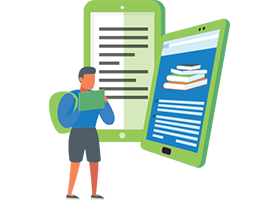
With the coronavirus outbreak leading to school closures worldwide, the pressure is on for teachers to deliver meaningful learning experiences without the classrooms and face to face time we usually take for granted.
There’s no getting around the fact that this is a massive disruption to say the least, but let’s not forget that the concept of distance education is hardly new. Moreover, we now have the added benefit of learning technologies that make teaching and learning remotely so much easier. It’s a luxury that didn’t exist at the time of the SARS or H1N1 outbreaks, and an absolute godsend when even the best laid plans go out the window in such dramatic circumstances.
That said, school closures do pose a dire threat to student learning if teachers don’t change up their methods accordingly. Here are ten vital strategies you should use to ensure that students maintain their learning momentum.
Use technology
School closures a decade ago might have meant sending students home with a packet of worksheets and your email address, but the technologies we have today allow rich learning experiences to be maintained even in the event of major disruption. Cloud based technologies are perfect for the job. Whatever you opt for, ensure that you accommodate:
- Collaborative work and engagement between students (e.g. a discussion forum)
- Work submissions (automated deadlines are a plus)
- A library of resources
- A point where students can contact you directly
Engage with parents
Ideally, parents should have a hand in keeping their child accountable for learning at home, but working commitments mean this is not always possible. Regardless, ensure that they are kept updated of their child’s progress so that they can have a hand in both motivating and managing them where necessary.
Hold tight to classroom management standards
Students might be outside the classroom, but they need to be aware that they are in a learning environment no less. Set strict guidelines and procedures for using technology responsibly, and articulate consequences for those who behave inappropriately. This is another area where parent support is of great benefit.
Plan for more than you need
Not knowing how long school closures will last means that you need to have plenty of content up your sleeve that is ready to be delivered remotely.
Maintain student communication
Don’t let relationships get lost in the digital mix. Take the time to comment on student work and check-in with individuals in order to maintain the connection, as this is a chief motivator in the success of online learners.
Follow-up with students who go AWOL
Distance learning makes it easy for students at risk to hide their difficulties, so check in with them privately in order to prevent long term work avoidance. Doing so also allows you to identify problems that might prevent students from accessing the material.
Set activities that have tangible results
Done alone and without immediate teacher follow-up, any activity that does not require students to complete or produce something will likely have limited results. Prioritize activities that require submission of some form in order to keep students accountable.
Set homework and self-study activities
It might seem like students are doing nothing but homework when they’re working offsite, yet they still need the opportunity to practice outside the time allocated for instruction. Online learning solutions such as Mathletics make it easy to set and check homework remotely in such a situation.
Be realistic about what you can achieve and adjust your programming accordingly
Content will likely take longer to cover when teaching remotely, so you will need to account for this in your planning – both for the time away and the eventual return to the classroom. Be flexible; don’t just stick to the original program if it isn’t going to work.
Hold students accountable
The onus doesn’t have to be on you exclusively as the teacher. Be firm when it comes to deadlines, expectations, and students’ obligation to speak up if they’re having trouble. If we encourage our students to take responsibility for their own learning, they may well return to class with more maturity, autonomy, and investment than ever before.
Still wondering how to handle the disruption? We have a few solutions of our own.

Keep your students learning wherever they are with our mathematics and literacy programs









